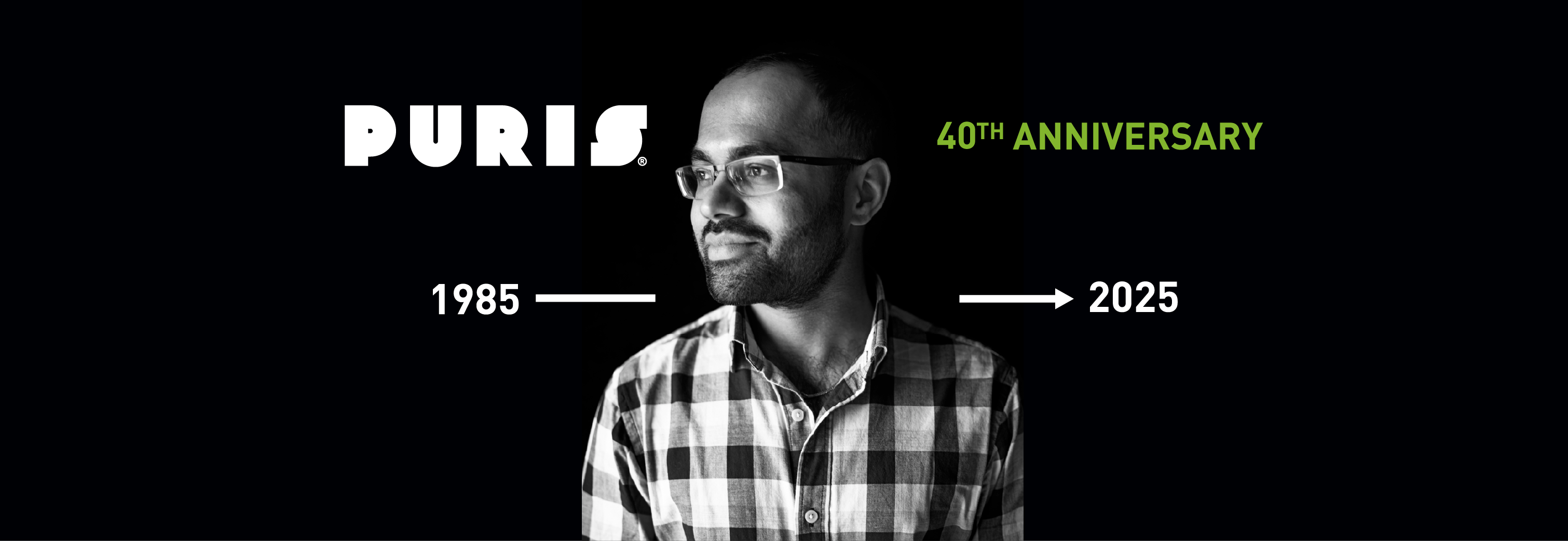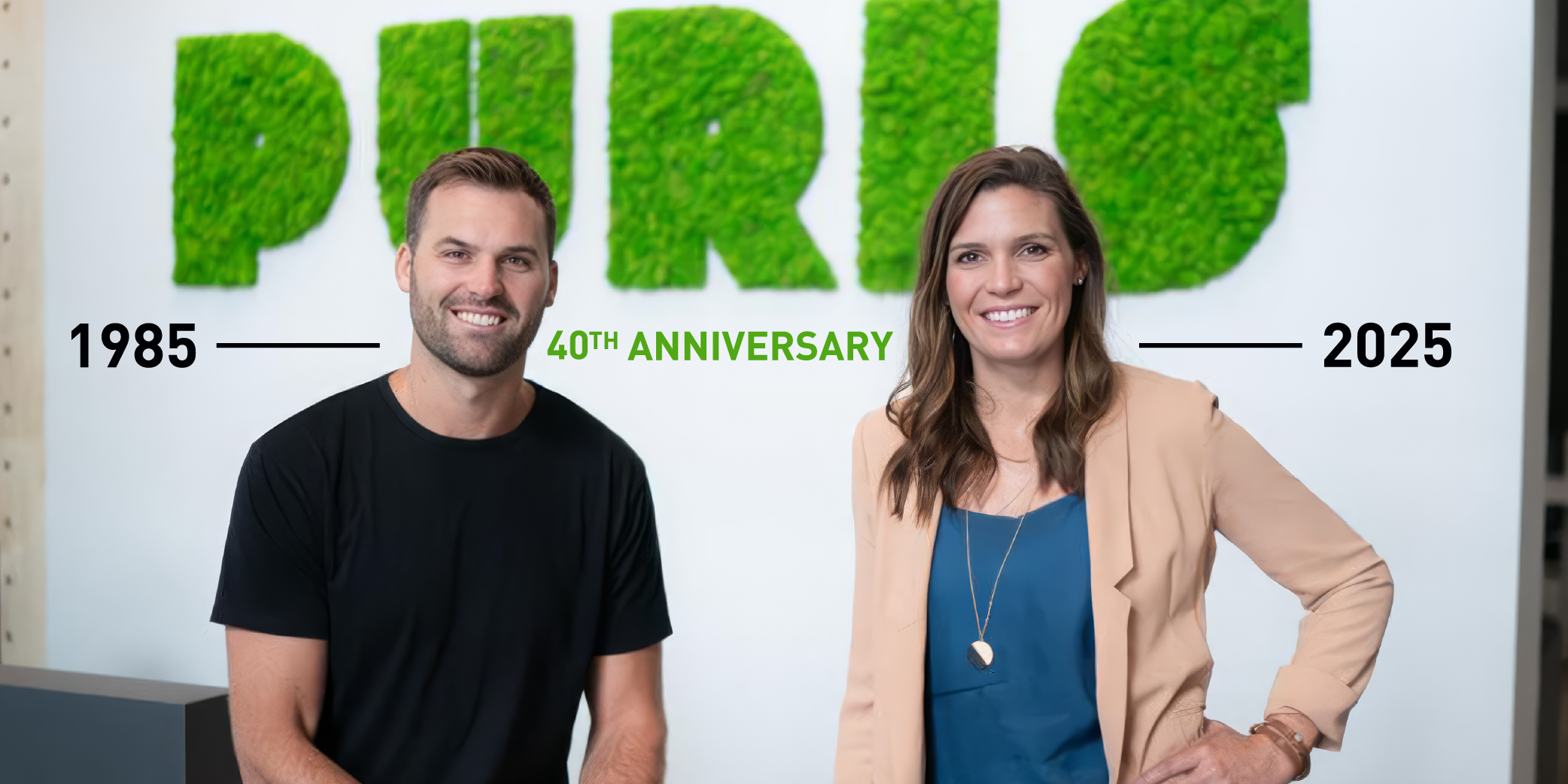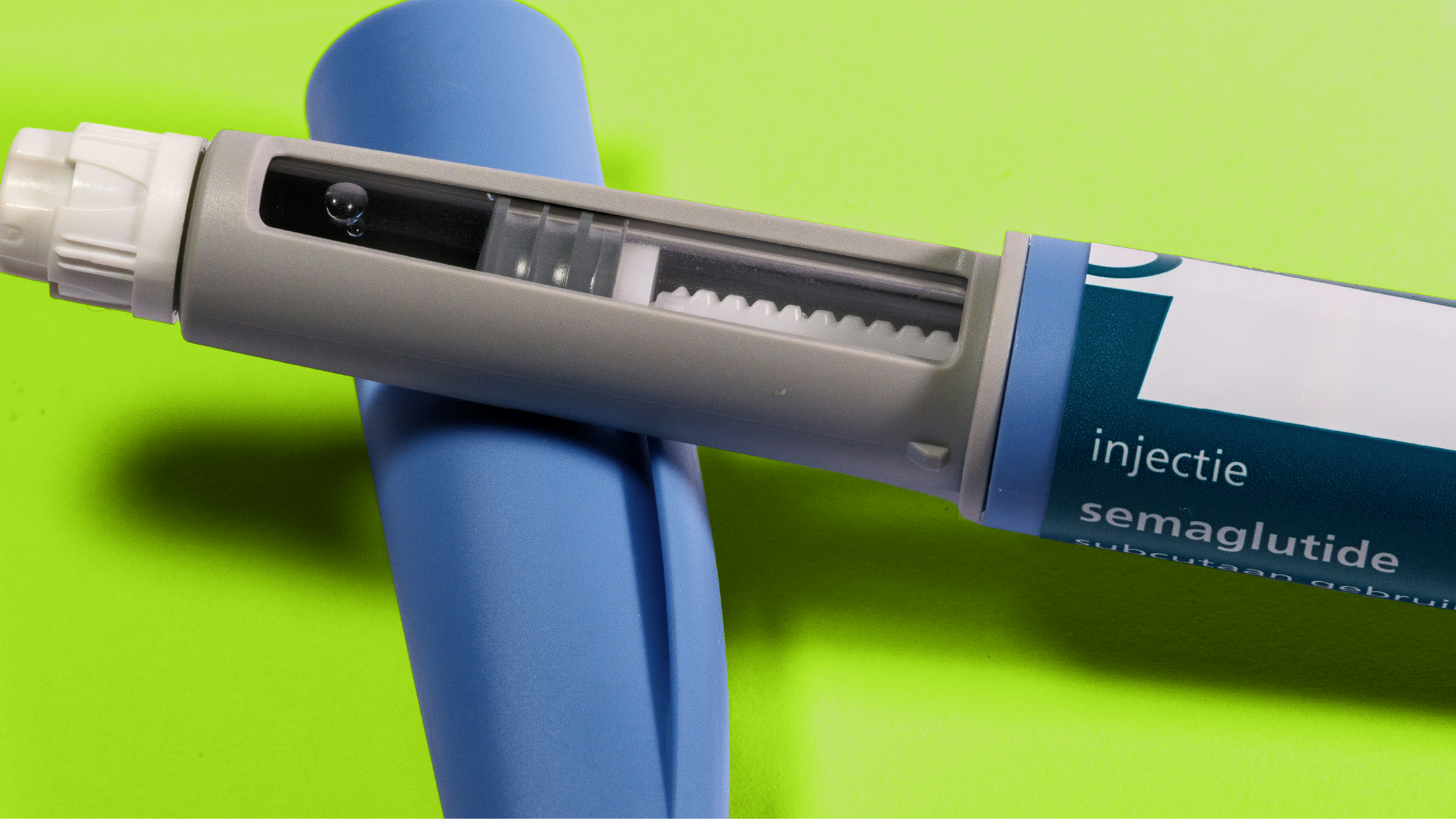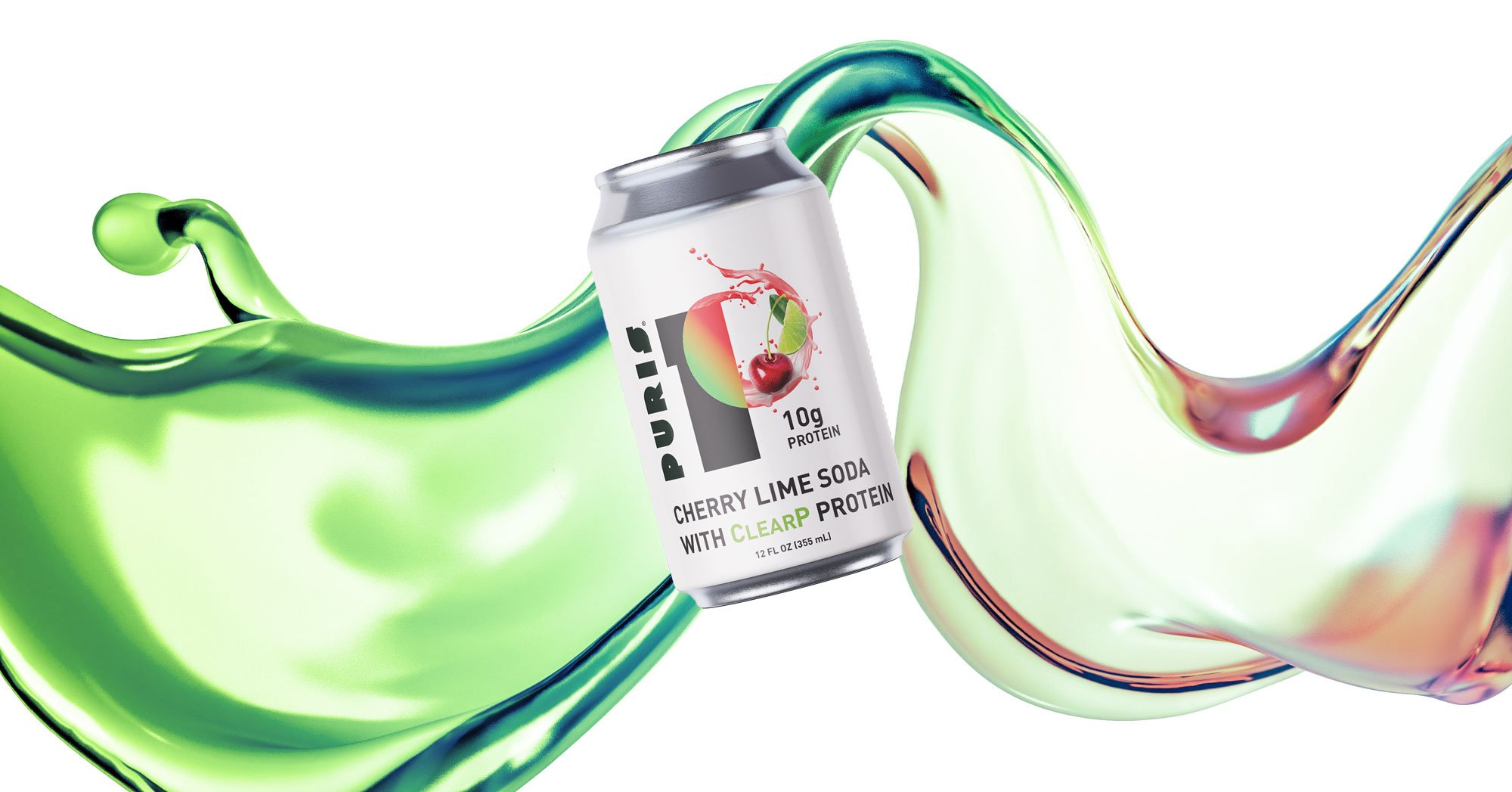As we continue celebrating 40 years of PURIS, we're highlighting the people behind our mission to build a better food system. We recently sat down with Kushal Chandak, Vice President of Research & Development and one of the longest-tenured members of our executive team, to reflect on his time with PURIS.

I sat down with Kushal “Kush” Chandak, our Vice President of R&D, who joined PURIS (then known as World Food Processing) in 2016. As the company’s first food scientist, Kush has been at the forefront of our pea protein innovation, working from the ground up to improve taste, functionality, and performance in real-world food applications.
Q: How did you first come to work at PURIS?
Kushal Chandak: I had just graduated with my master’s in food science from Michigan State and was in Michigan at the time, actively looking for a job. Like many recent grads, I was applying online, trying to find the right opportunity to start my career in food science.
One day, I got a call from Jerry Lorenzen. He had come across my resume online, and he reached out personally. We talked, and there was this immediate spark. He had this big vision for what plant-based could be, and it was so different from what I was seeing elsewhere.
Next thing I knew, I was packing up and moving to Iowa to join what was then called World Food Processing. It was a small team, very hands-on, and I was excited to jump in. I didn’t know it at the time, but that call from Jerry set the course for the next decade of my life.
Q: What was it like at the company?
Kushal Chandak: For the first four years, soy was my full focus, working on different soy flours and exploring how they could be used. I spent a lot of time making soy milk and tofu in the lab, which was a big part of my R&D journey. It wasn’t just about processing ingredients but about learning how they behaved in real applications. That experience taught me how to think from a technical and applied perspective.
We were doing a lot with soy flour and also exploring functional applications—how it performed in food systems, how to tweak processing to improve texture or flavor. Every trial was a lesson in problem-solving, and soy gave me a deep foundation for everything I do now. It was a lot of iterations.
I still remember my first week, I actually broke one of the machines. I didn’t know the equipment that well yet, and in trying to learn by doing, something went wrong. OMG, I was so scared because as a new employee, you’re breaking pieces of equipment. But no one made me feel bad about it. It became one of those early moments where I realized: this is a place where you learn by trying, by doing, and sometimes by failing. That moment stuck with me, not just for the mistake, but for the support and mindset that came with it.
Q: Tell me about when you met Jerry’s son, Tyler Lorenzen.
Kushal Chandak: I remember it very clearly. Tyler [now PURIS CEO] joined the team while I was deep in the soy work. This massive guy, a pro football player, walked in and ended up becoming my boss. When Tyler first tried one of the products I had been working on, a soy-based ice cream, he genuinely liked it. That moment meant a lot to me. Seeing someone with his background enjoy something I created made me really happy and motivated. It was more than just product testing—it was a real connection that showed the impact of our work.
Shortly after he came on board, we bought the Turtle Lake facility in Wisconsin. That was a huge milestone.
Q: What was Turtle Lake like at the beginning?
Kushal Chandak: It started as a soy protein isolate plant. We were doing soy-based processing there, trying to bring innovation into a space that hadn’t changed much in decades. But then came the pivot, we started to explore pea protein at Turtle Lake, and that transition came with its fair share of challenges.

Kushal Chandak and a customer at our Dawson, MN Pea Protein Plant
Q: How was the process of creating the first PURIS pea protein?
Kushal Chandak: The first time we tried to process PURIS pea protein, it was an absolute disaster, honestly. We were scaling up from benchtop experiments to full production, and the difference in scale was massive. In the lab, I was working with small, controlled batches, but suddenly we had truckloads of peas and equipment that wasn't built for them. It was overwhelming.
Things started going wrong immediately. I remember standing there as the system jammed and the product came out wrong, thinking, “What did I do wrong?” It was one of those moments where everything falls apart, and you just have to own it. There were steps I overlooked, things I assumed would translate from lab to plant that absolutely didn’t. It was frustrating and humbling, but it also sparked our learning process.
We failed fast and failed often. It took us two full years before we were able to consistently reach the protein content we were targeting. That was one of the biggest challenges—just getting the purity and functionality where it needed to be. We’d think we were close, then realize something fundamental still wasn’t working. Every run taught us something, and we slowly refined the process over time.
Peas are not soy. That became very clear, very quickly. Soy had been our foundation—we understood it. But peas behaved differently. The existing processing setup was designed for soy, so we had to rethink everything: extraction, separation, drying. We were inventing as we went.
Q: What made you keep going with peas?
Kushal Chandak: We knew pea protein was the future. At that point, soy was starting to feel like a highly developed commodity but also crowded and price sensitive. Peas, on the other hand, were just emerging, and we saw an opportunity to lead instead of follow. No one had cracked the code yet on how to make functional, great-tasting pea protein. That’s what motivated us. If we could figure it out, we could build something truly different.
Q: So, when did things finally click?
Kushal Chandak: I remember clearly a moment when we had a batch of pea protein that actually worked. I compared it to the leading competitor at the time, just side by side. I mixed both into water, stirred them up, and tasted them. And it hit me: “Omg, this is so good.” Our protein was cleaner, smoother, and had a way less bitter aftertaste. It felt like all the struggles had led to this.
That was the breakthrough. It was validation that all the trial and error, all the failures, had led us to something better. From that point on, it wasn’t about whether we could make great pea protein; it was about how far we could take it.
Sounds like it took some outside-the-box thinking.
Exactly. That’s Jerry’s DNA. He’s always been someone who looks at problems and sees opportunity. His philosophy was: if the market’s not ready, make it ready. Build the tech, build the process, and then find the customer.
That mindset was critical in those early days at Turtle Lake. Jerry empowered us to push boundaries, test bold ideas, and believe that we could make it real even if it didn’t exist yet. That permission to fail and learn carried us through figuring out pea protein.
 Minnesota Star Tribute Article on PURIS
Minnesota Star Tribute Article on PURIS
Q: What does sustainability mean to you in your work?
Kushal Chandak: To me, sustainability begins with how we utilize the entire pea. It’s not just about creating excellent protein, it's about ensuring nothing goes to waste. From the start, we understood that to scale pea protein, we had to find value in every part of the ingredient. That includes not only isolating protein but also using the starch, the fiber, and everything in between.
Early on, it was mostly about the protein. That was our main goal. But as we dug deeper into the process, we realized there was a lot of untapped potential. Peas naturally contain a lot of starch and fiber, so instead of throwing them away or treating them as byproducts, we found ways to turn them into valuable ingredients. That change helped us move toward real sustainability.
Today, our process is circular. Every part of the pea goes somewhere useful. It’s better for our business, better for our customers, and way better for the planet. That’s what sustainability means to me: building systems where efficiency and environmental impact go hand in hand.
Discussing reducing food waste or building resilient supply chains is not abstract. We’re doing it every day by rethinking how to make the most of a single, powerful crop.
Q: What’s been the most significant change you’ve seen at PURIS?
Kushal Chandak: The scale. We’ve gone from sending hand-labeled sample bags to shipping truckloads of ingredients to some of the largest food companies in the world. But what’s remarkable is that even with that growth, we’ve never lost the core of who we are. We’re still nimble, still creative, and still focused on doing things the right way.
Q: What’s your favorite part of your role today?
Kushal Chandak: I love working with the team. We’ve built an amazing group of scientists and engineers who challenge each other and constantly push boundaries. I also love working directly with customers, translating their challenges into real product solutions.
Q: What makes R&D at PURIS unique?
Kushal Chandak: We’re vertically integrated, which gives us an incredible advantage. We can tweak things at the farm, manufacturing, and formulation levels under one roof, which allows us to move faster and be more creative than most ingredient companies.
Q: What excites you most about the future of PURIS?
Kushal Chandak: There’s so much untapped potential in our ingredient portfolio. We’ve only scratched the surface of what’s possible with peas. Whether it’s nutrition, sustainability, or functionality, we’re just starting.
Q: Any final thoughts as we celebrate 40 years?
Kushal Chandak: Being part of a company with such a strong mission, incredible people, and meaningful impact is rare. I feel lucky to have grown with PURIS, and I’m excited for what’s ahead.

PURIS 40th Anniversary
As we celebrate PURIS's 40th anniversary, reflecting on our journey from humble beginnings in 1985 to becoming a vertically integrated company that spans seed genetics to finished consumer products is incredible. Our commitment to innovation and sustainability has driven us to develop high-quality pea ingredients made in the USA. This milestone is a testament to our dedication to transforming the food industry and positively impacting our customers and the environment. Please keep a lookout for more content on our 40th anniversary. Here's to many more years of growth and success!



